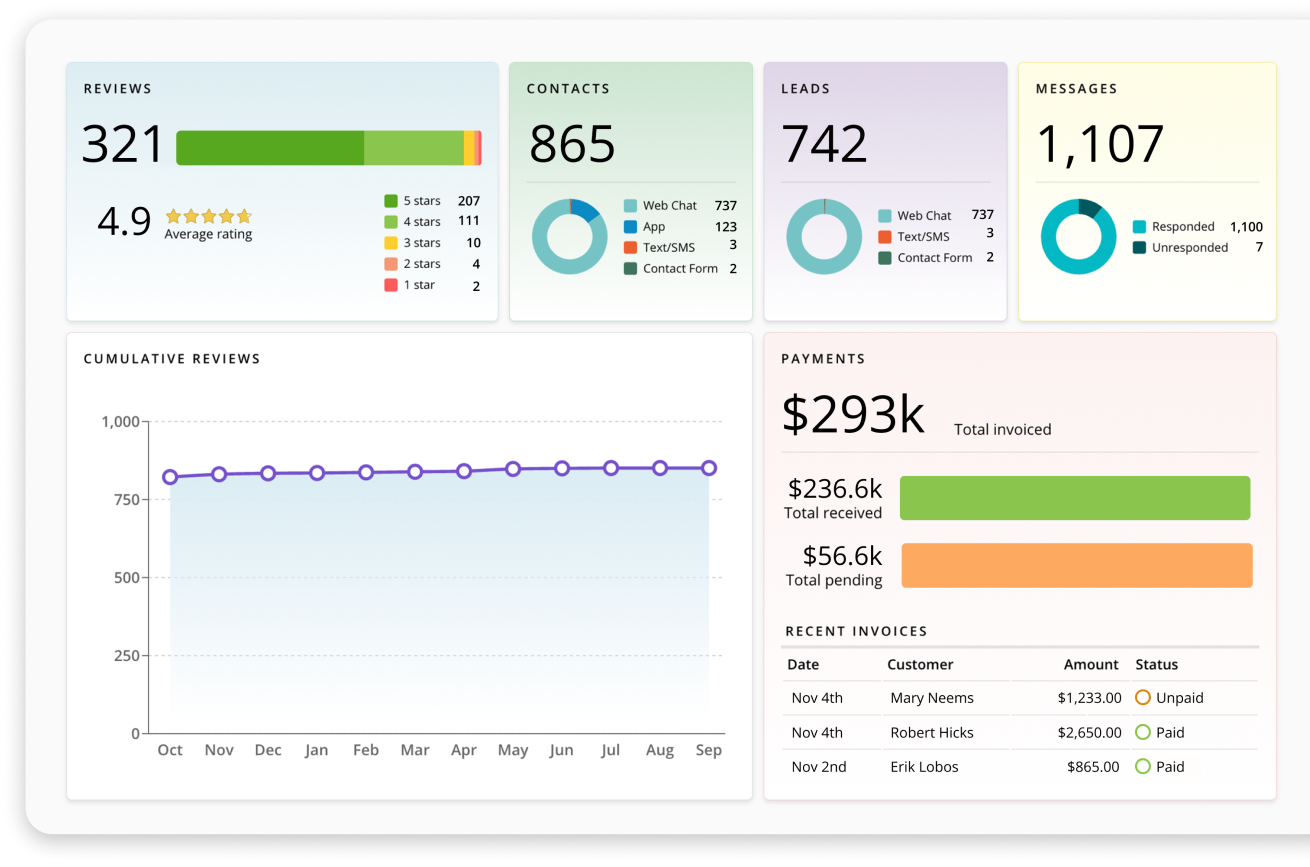
How to Trademark Your Business Name: A Step-by-Step Guide for Entrepreneurs
Alright, listen up, entrepreneurs! You’ve poured your heart and soul into building your business, so don’t leave its name hanging out there where someone else can claim it. Think of it as putting a big, bold stamp of ownership on your brand—something no one else can.
In this guide, we’re diving into the nitty-gritty of trademarking and will show you exactly how to trademark your business name. So buckle up, and let’s get started on securing your slice of the business world!
Automatically request reviews to amplify your online reputation
What Are Trademarks?
A trademark is like a shield for your business’s name or logo. It’s that special badge that sets you apart from the crowd and tells the world, “Hey, this is MY brand, so hands off.” Think of it as your business’s personal bodyguard, keeping copycats and wannabes at bay.
Famous trademarks include Instagram, McDonald’s, Google, Apple, Nike, etc.
Legally speaking, a trademark offers you some serious muscle in the world of business. It’s your ticket to exclusive rights over your brand identity, preventing others from using or copying it without your permission.
Do Local Service Businesses Need a Trademark?
Absolutely! Trademarks aren’t just for the big shots; they’re beneficial for businesses of all sizes, especially local service providers. Your trademark is the guardian of your reputation. It’s important to remember that it’s not just protecting a name or logo; it’s also safeguarding the trust and loyalty you’ve built with your customers.
As your business gains traction in your community, your trademark becomes a symbol of reliability and quality, showing customers that you’re the real deal. So yeah, as your business grows, your trademark becomes even more valuable and worth maintaining.
Step 1: Determine if Your Business Name Can Be Trademarked
Is your business name trademark-worthy?
Before diving headfirst into the trademarking world, let’s make sure your business name is up to snuff. Here’s what you need to do:
Distinctiveness is Key
Your business name needs to stand out. It should be unique, memorable, and not just a run-of-the-mill term. Think of it like your business’s fingerprint—it’s got to be one of a kind.
Avoid the Bland
Non-descriptiveness is a big no-no. Your name shouldn’t be generic or just describe the products or services you offer. You want something that sparks curiosity, not just states the obvious.
Name Game Check
Time to play detective! Before you get too attached to your business name, do a quick check to see if someone else has already claimed it. You can start with a simple Google search or dive deeper into the trademark database to see if your name is already taken. After all, you don’t want to be stepping on anyone else’s toes.
Also see: How to Check Business Name Availability in the USA
Step 2: Prepare for the Trademark Application
Conduct a Thorough Search
Before you dive headfirst into the trademarking process, you must conduct some research. Use the U.S. Patent and Trademark Office’s Trademark Electronic Search System (TESS) to scout out any existing trademarks that might be similar to yours. This step is important because the USPTO won’t approve your trademark if it might be confused with an existing one. Remember to cast a wide net and search for variations and similar names, as even subtle similarities can lead to application rejection.
Identify Your Mark’s Format
Now that you’ve scoured the trademark database and confirmed that your name is unique, it’s time to decide how you want to present it to the world. There are two main formats to choose from: standard character marks and stylized/design marks.
Standard character marks protect your name in its basic text form, while stylized/design marks cover specific fonts, colors, or design elements. Remember when Coca-Cola tried to reformulate its iconic soft drink and things backfired horribly? That’s why it’s so vital to consider your brand’s identity and audience when making such a big decision.
If you want to keep things simple and versatile, a standard character mark might be the way to go. But if you have a distinct visual style that sets you apart, a stylized/design mark could prove more useful. When in doubt, however, the standard character mark is best for those who plan to change things up now and then with their branding.
Specify Your Goods and Services
One of the trickiest parts of the trademark application process is accurately classifying your goods and services. The USPTO uses a classification system to organize trademarks based on the types of products or services they cover.
To avoid conflicts and rejections, it’s very important to classify your goods and services correctly. Take the time to research the appropriate class for your offerings and provide a precise description that clearly outlines what you do. This not only helps streamline the application process but also reduces the risk of potential disputes down the line.
Step 3: File the Trademark Application
Understanding the Application Process
Now that you’ve done your homework and prepared all the necessary documentation, it’s time to take the plunge and file your trademark application. Fortunately, the USPTO offers a convenient online filing option through its Trademark Electronic Application System (TEAS) and accepts electronic payments.
This user-friendly platform guides you through each step of the application process, from entering your personal details to specifying your goods and services. Simply follow the prompts, upload your documents, and submit your application.
Application Costs
But before you hit the submit button, it’s important to understand the costs and timelines associated with the trademark application process. While the basic filing fees can be as low as $250, the total expenses may vary depending on factors such as the number of classes you’re registering for, whether you work with a legal team, and whether you opt for additional services.
It’s also worth noting that the entire approval process can take 12-18 months or more, so patience is key. But trust us—the wait will be well worth it when you see your business name officially trademarked!
After You File: What to Expect
Congratulations—your trademark application is officially in the hands of the USPTO! But what happens next?
After you hit submit, your application will undergo a thorough examination process to ensure compliance with trademark laws and regulations. This includes reviewing your documentation, conducting a search for conflicting marks, and assessing the validity of your claims.
If everything checks out, your application will proceed further down the process on its journey to approval. However, if any issues or discrepancies are identified, you may receive an office action requesting additional information or clarification.
Responding to these letters on time is crucial to the success of your application, as failure to do so can delay or even nullify your trademark request. But don’t panic, this deadline to respond is relatively generous, at 3 months from the issue date of the office action.
Possible Outcomes of Your Application
While we’re rooting for a smooth approval process for you, it’s also a good idea to prepare for all possible outcomes. You see, in some cases, your application may be approved without any hiccups, and your trademark will be officially registered—which is great!
However, if the USPTO identifies any issues or if your application is opposed by third parties, you may receive an office action or notice of opposition. Don’t worry—these are standard parts of the trademarking process, and there are steps you can take to address them. Whether it’s providing additional documentation, responding to objections, or seeking legal advice, planning for these outcomes well in advance can help you navigate any challenges that arise.
How to Maintain and Enforce Your Trademark
Once your trademark is approved and registered, the journey isn’t over; it’s just beginning. To maintain your registration and keep your trademark active, you’ll need to fulfill certain ongoing requirements and responsibilities.
This may include filing periodic maintenance documents, paying renewal fees, and actively using your trademark in commerce. By staying vigilant and up-to-date on your paperwork, you can ensure that your trademark remains a valuable asset to your business for years to come.
Enforcing Your Trademark Rights Against Infringement
But wait—there’s more! As the proud owner of a trademark, you also have the power to protect your name and reputation from would-be infringers and copycats. You can protect your brand’s integrity and reputation by monitoring the marketplace for unauthorized use of your trademark and responding quickly to infringement.
Whether it’s sending cease-and-desist letters, pursuing legal action, or engaging in alternative dispute resolution methods, you can defend your trademark rights and preserve the uniqueness of your brand.
Keep Tabs on Your Brand with Broadly
So, there you have it! That’s how to trademark your business name.
Trademarking your business name is a big deal, but it’s an important step in protecting your brand and standing out in the market. While the process might seem overwhelming, taking action now can save you major headaches down the road.
While Broadly can’t assist with trademarks, we’re here to support you in other ways. Our reputation management software helps you keep a close eye on what people are saying about your business online. With our platform, you can monitor reviews, manage your online reputation, and ensure that the brand image you worked hard to trademark stays strong.
Ready to take control of your online reputation? Request a demo of our reputation management software today and see why so many local businesses choose Broadly.
Don’t let your brand’s reputation be left to chance—empower yourself with Broadly and take back charge of your online presence.
Transform your local business with revolutionary AI-powered software

